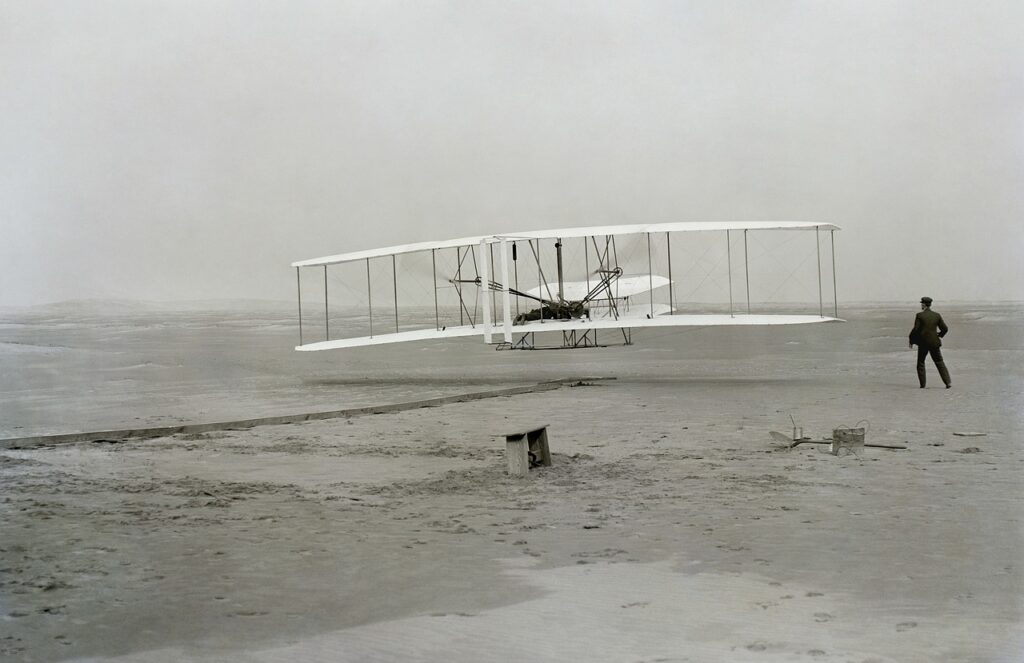At the First Air Show, People Still Didn’t Believe Flight was Possible
With just one month left until we take off for the famous Farnborough Airshow in the United Kingdom, we thought we would take a look back at the very first air show, when the Wright brothers put their “flying invention” on display for a skeptical audience of U.S. military brass, a few low-ranking politicians, and a few newspapermen. Needless to say, they liked what they saw.
Meet the Wright Flyer: The First Airplane
The first successful flight of a self-propelled, heavier-than-air aircraft (an airplane and not a balloon, in other words) occured at Kitty Hawk, North Carolina in 1903. It took six more years, however, for the public to believe it had really happened.
In 1903 the world was in the early years of the Zeppelin Era. Rigid airships, what we today might ball a blimp, were commonplace. They stayed aloft thanks to hydrogen cells that made the crafts lighter than the surrounding air. Numerous heavier-than-air flying inventions had been tried and all of them had failed, some spectacularly so. The U.S. military had spent $50,000 on a contract for the Langley Aerodrome. It had been constructed by the nation’s leading engineer, and spent just seconds airborne before plunging into the Potomac River. Simon Newcomb, America’s most prominent scientist, agreed and published extensively on the subject, demonstrating with “unassailable logic” why man couldn’t fly.
The Wright Flyer, meantime, was coming together in Orville and Wilbur Wright’s bicycle repair shop in southwest Ohio. A biplane made of giant spruce with a bicycle-inspired sprocket chain drive that powered the twin propellers, the Wright Flyer was a breakthrough — the first airplane with three-axis control, which allowed the pilot to steer the aircraft and to effectively maintain equilibrium. After testing the flight and proving the concept in Kitty Hawk, NC they returned to Ohio and looked for a place to improve the design.
A Skeptical Public
Though news of their maiden flight had leaked out, the Wright brothers were reluctant to show anyone their airplane, fearing patent theft. Anyhow, people were not inclined to believe that it worked. By 1905 they were flying serious distances — 20 or 30 miles at a time. School children would report seeing the flying machine circle the field for up to five minutes, as would local farmers. Yet local and national newspaper editors were convinced that the local brothers were con artists.
According to Luther Beard, managing editor of the Dayton Journal, “I used to chat with them in a friendly way and was always polite to them because I sort of felt sorry for them. They seemed like well-meaning, decent enough young men. Yet there they were, neglecting their business to waste their time day after day on that ridiculous flying-machine. I had an idea it must worry their father.”
Frank Tunison, another of the editors, who also represented the Associated Press, had turned down the story of the first flight at Kitty Hawk. Whenever he saw an occasional reference to them in local papers, would comment “Why do we print such tripe?”
Another reason the Wright brothers invention did not receive the attention it deserved was that an executive of the Scientific American, the biggest scientific journal in the country, was friends with another aspiring aeronautical engineer, and was convinced that his friend was on the verge of a breakthrough. Even after receiving eyewitness testimony from Ohio, he refused to print the story.
The First Air Show
The tide shifted when the governments of France and Germany began showing interest in the Wright brothers airplane, and the U.S. government hastily offered the brothers a contract to prevent the technology from falling into foreign hands. Still, the Wright brothers would have to demonstrate their invention before a skeptical crowd at Fort Myers in Virginia. Most in the government were in attendance for no other reason than put “this Wright brothers business” to bed once and for all so they could devote their time and resources to more promising projects.
The moment Orville Wright lifted the plane off the ground, the crowd gasped in astonishment. After flying at 40 miles per hour, maneuvering in any and every direction, for over an hour non-stop, Orville landed the plane. He was immediately rushed by several newspapermen for an interview. Each of them had tears streaming down his cheeks.
About Aerospace Manufacturing
Aerospace Manufacturing is a AS9100 and ISO:9001 accredited aerospace fastener manufacturer that creates a diversified line of quality screws, quality aerospace bolts, aerospace pins, and aerospace studs. Our clientele includes leading OEMs and aerospace organizations like Bombardier, DLA, Lockheed Martin and NAVICP.
Search our expansive inventory or launch your Custom Quote today!





